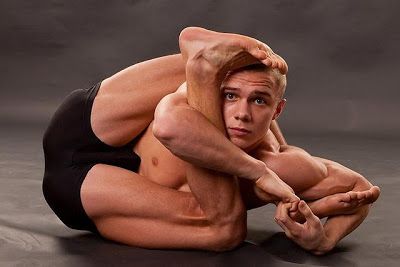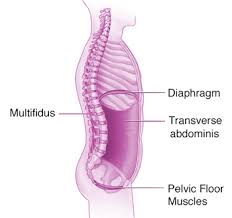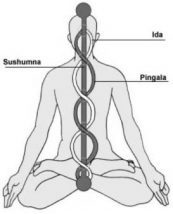Many yogis have been practicing yoga for years, even decades, still consider themselves and feel “tight” in their muscles. There are 3 good reasons why this may be.
1. Joint Hypermobility
There is some confusion in the Yoga industry with the difference between flexibility and hypermobility. Social media posts of people in extreme contortions doesn’t help! Hypermobility refers to having an excess range of motion of a joint. A joint is where two bones meet, are surrounded by fibrous connective tissue, consist also of cartilage and also allows for body parts to move. To give a visual example, take a look at this shoulder joint.

Hypermobile people appear much more flexible than the average person. Taking a closer look at how and where these bodies are moving from, one will see that they are getting a lot of excessive range of movement from the joint itself rather than the muscles alone. The hypermobile person will feel like they have to push further to feel anything, which can lead to a habit of seeking sensation than practicing safely with good structural alignment. Yoga requires much more muscular work when one is hypermobile because one has to work twice as hard to stabilize the joints. Muscles can get overly tight and guarded because they are trying to protect the hypermobile or unstable joint.
How does one know if they are hypermobile?
If the elbows and knees hyperextend….most likely hypermobile.
If one is considered “double-jointed”…..definitely hypermobile.
Here are some common visual examples:

Shoulder hyperextension in down dog (left pic) – would feel armpit area stretch
Elbow hyperextension in plank (left pic) – would feel front of elbow joint stretch
How does hypermobility feel like?
However this may have presented itself, one will know it when practicing Yoga because it will feel like a joint stretch vs. a muscle stretch. Think of feeling a stretchy sensation at the crease of your elbow, your shoulder joint, your knee joint, your hip joint or your SI (sacro-iliac) joint vs. feeling the stretch in the muscle belly of the biceps or hamstrings. Please CLICK HERE for a few self-correction techniques for experience SI dysfunction (aka the pelvis going out of alignment).
There are more severe conditions of extreme hypermobility or connective tissue disorders, such as Ehlers Danlos Syndrome, but I am talking more about the average hypermobile type. Some of us are born with a genetic predisposition toward hypermobility. Some of us experience overstretch injuries, overstrain injuries, traumatic falls or car accidents that have led to hypermobility in one or two specific joints.
It is vital to find a balance between mobility and stability in your joints, especially when practicing Yoga. This is part of what makes a Yoga practice sustainable over time.
2. Stretching Tissue That Does Not Recoil
This one often accompanies someone with joint hypermobility, but is not limited to those with it. Most people know that if you stretch your hamstring (or any muscle), it’s eventually going to need stretching again. This is because muscles have the ability to recoil, meaning to come back to their original position. Ligaments, which connect bone to bone and surround & provide static (at rest) stability to your joints. Ligaments DO NOT have the ability to recoil! So to a certain degree, once a ligament has been overstretched, they don’t go back to their original degree of tautness. This is called ligamentous laxity (or looseness). This is especially true if one just keep stretching ligaments vs muscles (like in the above down dog and plank photos). When you think of flexibility, think of MUSCLE flexibility rather than joint! If joint mobility is too excessive, it can lead to instability.
Once the ligaments are overstretched, the joint’s stability will be compromised. As with joint hypermobility and instability, the muscles will work harder to stabilize the joint that is now surrounded by lax ligaments. This leads to chronically feeling tight in an area, even if you’re stretching it a lot!
Tips for #1 & #2
- Stabilize what is too mobile
- Draw bones toward their sockets, especially the humerus (upper arm bone) and femur (upper thigh bone)
- Focus on contracting the muscles to stabilize the loose joint(s)
- Practice backing off, rather than pushing further
- Slightly bend the elbows and knees.
- Use props, such as blocks, for support.
- Focus on aligning the bones vs seeking the stretching sensation
And remember that some may have resistance to backing off their practice. This is especially true because our society showcases and idolizes asana (physical postures) that require extreme ranges of motion.
To access alignment-based Hatha Yoga practices for $1, please CLICK HERE.
3. The Overactive Sympathetic Nervous System

If neither one or two feels like something that’s been experienced, but one still has the experience of doing a lot of Yoga and still feeling tight it may be because the sympathetic nervous system (SNS) is overactive. Our SNS, or fight or flight mode, is meant for short and powerful spurts of energy and is vital for helping us notice, deter or escape from potentially dangerous situations. What has happened in our highly technological, fast-paced and overly stimulating society is that many people are always feeling a sense of anxiety, stress or overwhelm. And when we are under stress for long periods of time, the SNS becomes overactive. In other words, our stress becomes a neurological habit that literally affects every system of the body. Some symptoms may include:
- muscle tension
- increased pain and inflammation
- poor digestion/indigestion or constipation
- anxiety, shallow breathing and increased heart rate
- poor quality sleep, restlessness and night sweats
- decreased libido, fatigue and nervousness
- increased agitation/irritability
- decreased immunity leading to increased susceptibility to illness
If this sounds familiar, I would encourage breathwork and meditation to calm the SNS and strengthen the parasympathetic nervous system (PNS), aka our rest, digest and repair mode. The quickest way to calm your own nervous system is to double the length of your exhalations. But also be aware that once your fight or flight response has been activated, it physiologically takes about 20 minutes for the system to come back to homeostasis.
To access online breathwork and meditation practices for $1 that reduce stress and strengthen the PNS, please CLICK HERE.
I truly hope this information supports you and your practice!
Dr. Somer Nicole
Founder of YogaDoctors.TV
Doctor of Physical Therapy
Kundalini and Hatha Yoga Teacher
CranioSacral Therapist & SomatoEmotional Release Practitioner
Reiki Master/Teacher




